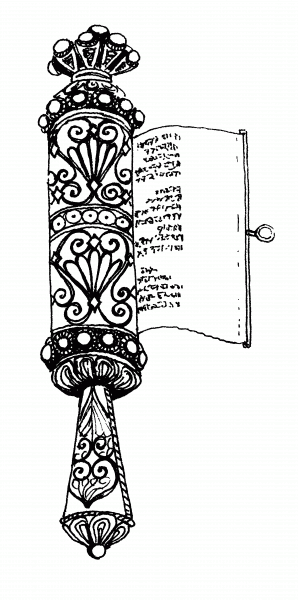Glossary
The entries selection comes from the book “Dictionary of Judaica” (2005), which was written by a group of authors led by Eva Kosáková . Entries were further processed by Jaroslav Kuntoš, Dana Veselská, Olga Sixtová, Michaela Scheibová and Lenka Uličná. The book can be purchased at our e-shop.
Scroll of Esther (Heb. Megilat Esther)
A reading of the Book of Esther forms part of the liturgy of Purim. For the purposes of public readings in the synagogue, it is hand-written in Hebrew with Hebrew square letters in the form of a parchment scroll without vocalization or adornments. Scrolls made for individual persons are often illuminated (with purely decorative motifs or scenes that illustrate the various passages of the text). Scrolls are also sometimes printed, decorated with various techniques and have ornate printed borders and hand-written texts. The scroll of Esther is usually about 1 to 3 metres in length and is kept in a protective case. For larger scrolls intended for the synagogue, this case has a purely protective function, a simple cylindrical shape without adornments and is made of wood or iron sheet. With smaller objects intended for private use, one of the ends is firmly attached to the central winding axis of the case and the scroll is gradually taken out through a slot in the case during the reading. The rewinding is done with a button or a small appendage connected to axis of the case; for ease of handling, the case is provided with a handle at one end. The case is usually decorated in filigree and made of silver. The usual size of this kind of case is about 20 centimetres, although it may be larger.
Back to list


![[subpage-banner/2_pamatkyaexpozice_1.png]](https://c.jewishmuseum.cz/images/subpage-banner/2_pamatkyaexpozice_1.png)

![[design/2013/Twitter.png]](https://c.jewishmuseum.cz/images/design/2013/Twitter.png)
![[design/2013/Instagram.png]](https://c.jewishmuseum.cz/images/design/2013/Instagram.png)

![[homepage-banner/incident.jpeg]](https://c.jewishmuseum.cz/images/homepage-banner/incident.jpeg)